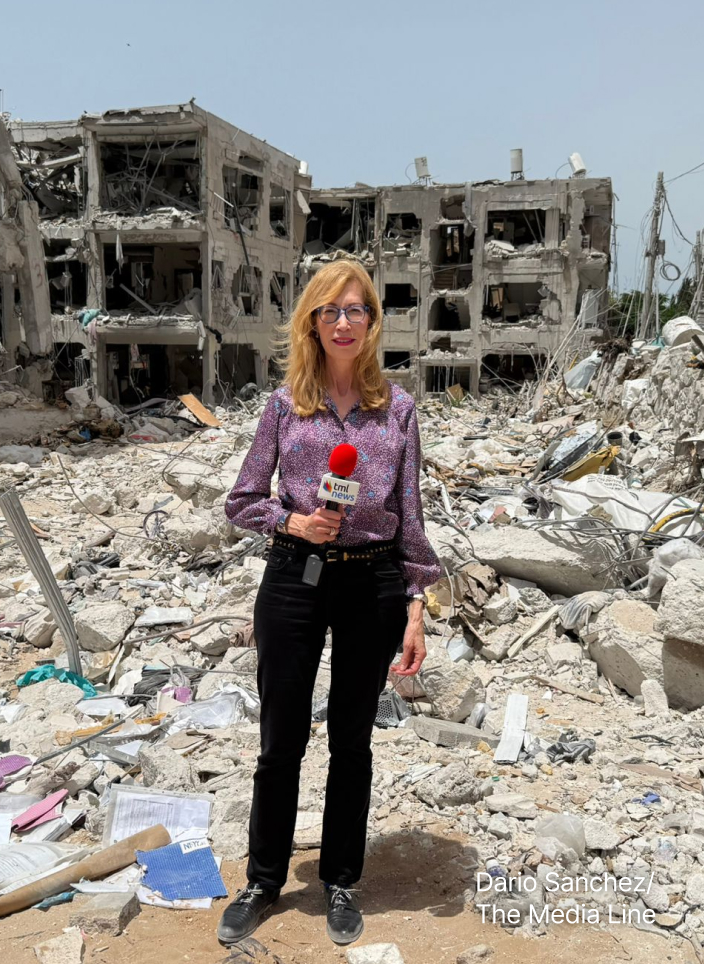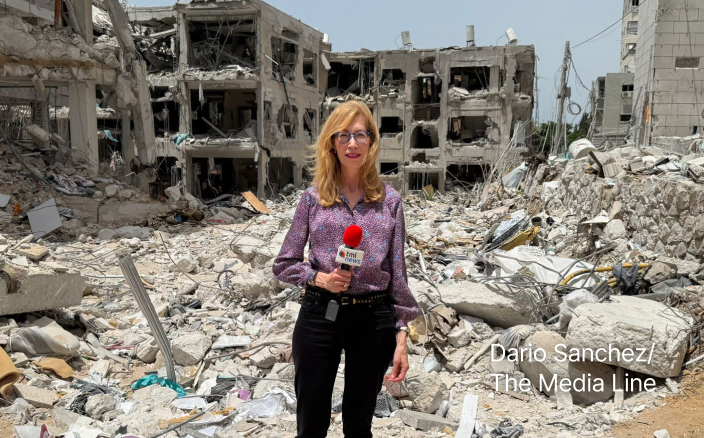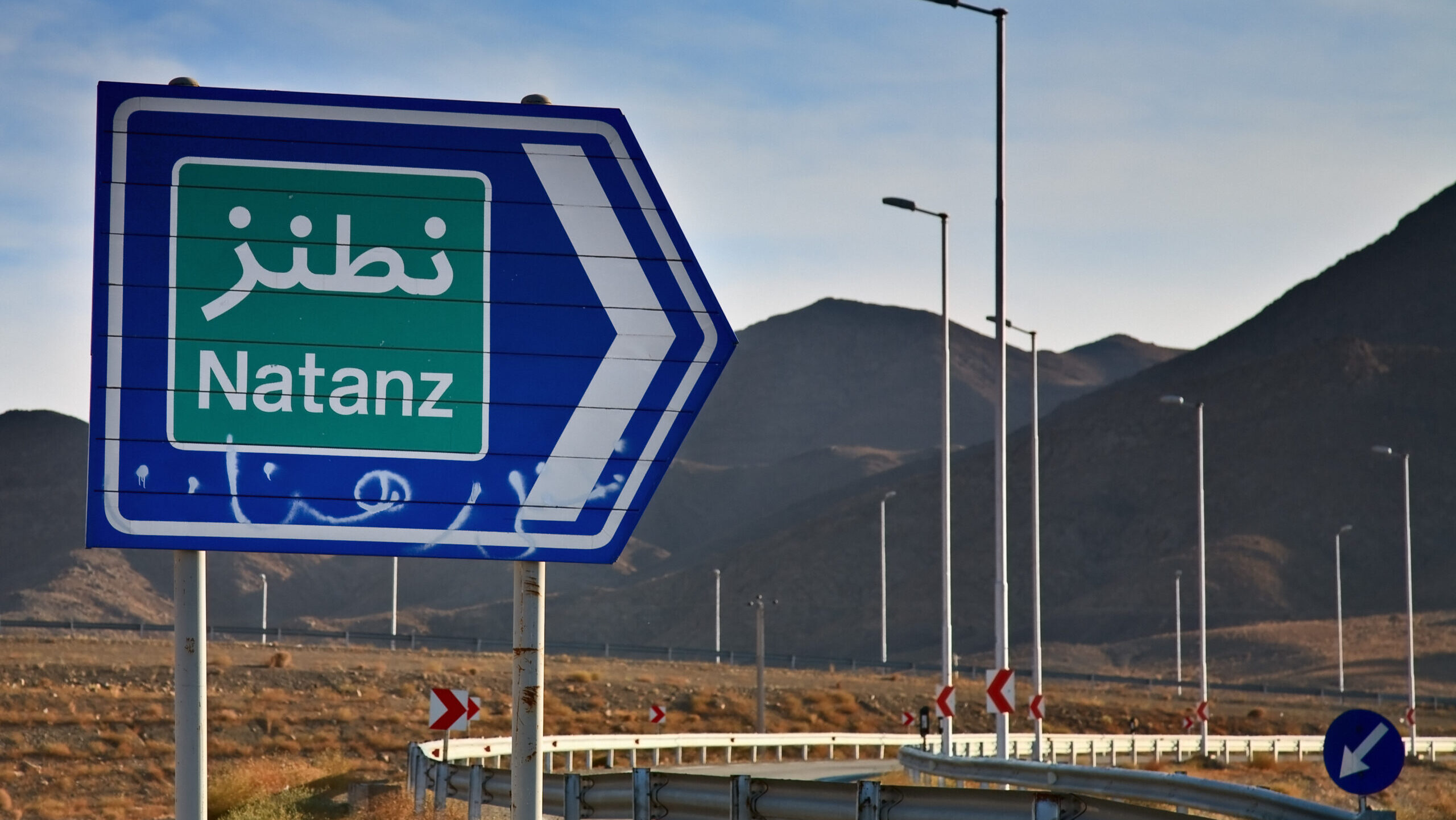Iran’s Nuclear Gamble: Buying Time or Looming Threat?
Iran is thought to have fissile material and technical knowledge to build a nuclear bomb, leading experts to suspect that the country will slowly continue to develop its weapon while trying to negotiate as many benefits as possible
Recent developments in Iran’s nuclear ambitions indicate that the Islamic Republic is on the cusp of achieving a nuclear weapon. Many experts estimate that the Iranian regime should already have enough fissile nuclear material to build a few bombs if the leaders decide to.
This analysis seems to be a consensus among experts, but Iran’s next steps remain a matter of discussion. After Israel assassinated a Hamas leader in Tehran last month, the world’s focus remains on Iranian threats of retaliation—but all the while, Iran may be quietly starting a new era of diplomacy under the Islamic regime.
Andrea Stricker, deputy director of the Foundation for Defense of Democracies’ Nonproliferation and Biodefense Program, told The Media Line that Tehran now can produce weapons-grade uranium for at least 13 nuclear weapons in under four months.
Iran is steadily reducing the time it requires to make multiple nuclear weapons while hardening its nuclear assets underground and reducing international oversight.
“Iran is steadily reducing the time it requires to make multiple nuclear weapons while hardening its nuclear assets underground and reducing international oversight,” she said, noting that recent intelligence indicates that Iranian scientists have been engaging in atomic weaponization activities.
Shahin Modarres, the Iranian desk director at the International Team for the Study of Security Verona, detailed the discrepancy between Iran’s nuclear program and its public statements.
“According to various sources, including Israeli officials and the International Atomic Energy Agency (IAEA), publicly, the Iranian government asserts that their nuclear activities are purely for peaceful energy production. However, uranium enrichment to levels as high as 60% and above suggest otherwise. This level of enrichment is far beyond what is necessary for civilian energy purposes and strongly indicates an intent to develop nuclear weapons,” Modarres told The Media Line.
Stricker evaluated the West’s response to these developments as tepid at best. “Washington and its European allies have fallen prey to an Iran-created dynamic,” she said, referring to the regime’s strategy of threatening to move to 90% enrichment—atomic weapons-grade—if the West pushes back too hard. The US has also not enforced sanctions on Iran’s oil exports, resulting in billions of dollars of sanctions relief, and has also provided Tehran access to foreign-held assets. All in all, “the regime has been able to inch closer to the bomb while reaping the benefits of a slow approach and diverting international penalties,” Stricker said.
Dr. Raz Zimmt, a senior researcher at the Institute for National Security Studies at Tel Aviv University, offered a slightly different perspective. Zimmt acknowledged Iran’s significant, though gradual, progress in its nuclear program in the years since President Donald Trump withdrew from the Iran nuclear deal. But he said that Iran likely has not made a definitive decision to develop nuclear weapons.
He said that Iran could potentially develop a nuclear weapon within six months to two years, depending on the type of weapon.
Iran is in a threshold position, meaning it could accumulate enough fissile material for a few nuclear devices within two weeks. However, possessing fissile material is not enough; Iran would still need to continue its weaponization process. Iran does have delivery methods, such as missiles, but these would need further adaptation to carry nuclear warheads. While it’s technically feasible, additional work is required to make them fully operational for this purpose.
“Iran is in a threshold position, meaning it could accumulate enough fissile material for a few nuclear devices within two weeks,” he said. “However, possessing fissile material is not enough; Iran would still need to continue its weaponization process. Iran does have delivery methods, such as missiles, but these would need further adaptation to carry nuclear warheads. While it’s technically feasible, additional work is required to make them fully operational for this purpose.”
According to Modarres, Iran currently has two of the three critical components needed to assemble a nuclear weapon. Once it achieves the technology to initiate a nuclear explosion, that will complete the trifecta, along with the delivery system and sufficient quantities of highly enriched uranium that it already possesses.
This development places Iran alarmingly close to achieving a fully functional nuclear weapon.
“Reports indicate that within the Iranian Ministry of Defense and the Islamic Revolutionary Guard Corps, efforts are ongoing to develop the necessary technology to trigger a nuclear explosion,” Modarres said. “This development places Iran alarmingly close to achieving a fully functional nuclear weapon.”
Give the gift of hope
We practice what we preach:
accurate, fearless journalism. But we can't do it alone.
- On the ground in Gaza, Syria, Israel, Egypt, Pakistan, and more
- Our program trained more than 100 journalists
- Calling out fake news and reporting real facts
- On the ground in Gaza, Syria, Israel, Egypt, Pakistan, and more
- Our program trained more than 100 journalists
- Calling out fake news and reporting real facts
Join us.
Support The Media Line. Save democracy.


Similarly, Dr. Zimmt assesses that Iran aims to maintain its position as a threshold nuclear state or as close as possible to it. Iran views its nuclear program as a form of insurance for the regime’s stability. “When Iran compares the US’s attitude toward North Korea with its attitude toward Iraq, it likely concludes that having nuclear capabilities makes a country less vulnerable to military threats. However, Iran’s objective is not to reach this position as quickly as possible, but rather in a way that minimizes the risk of military confrontation, particularly with the US.”
For Dr. Zimmt, Iran’s endgame is about maintaining its position as a threshold nuclear state, which he describes as “insurance for the regime’s stability.” He argues that Iran’s leadership likely sees the possession of nuclear capabilities as a deterrent against military threats, especially from the United States. “However, Iran’s objective is not to reach this position as quickly as possible, but rather in a way that minimizes the risk of military confrontation,” he explains.
Highlighting Iran’s internal economic challenges due to the sanctions imposed by the West, Dr. Zimmt assessed that “One of the key reasons for Iran’s economic crisis in recent years has been the economic sanctions. One of the key reasons for Iran’s economic crisis in recent years has been the economic sanctions imposed on the country.”
While removing these sanctions is necessary for improving Iran’s economy, it is not sufficient, the expert from INSS elaborated. “Mismanagement and corruption also play significant roles in Iran’s economic difficulties. The Iranian leadership, particularly Supreme Leader Khamenei, seems to have accepted that sanctions are a permanent fixture, especially after the US withdrawal from the JCPOA. Consequently, their strategy has shifted toward adapting the economy to survive under sanctions rather than seeking their removal.” he noted.
Iran’s nuclear program has had severe economic and diplomatic repercussions, according to Modarres. “Economically, it is estimated that Iran has lost around $1 trillion due to sanctions and the international isolation that has resulted from its nuclear ambitions. This has left the Iranian population struggling under a crippling inflation rate of approximately 76%, leading to widespread economic hardship. Diplomatically, Iran’s aggressive stance and the use of proxy groups have destabilized the Middle East, deteriorating the quality of life across the region and damaging Iran’s relations with numerous countries worldwide,” he explained.
There is a divide between the hardliners and conservative elements in the regime and the more pragmatic factions. While reformists are no longer part of the decision-making process, more pragmatic leaders, such as the current President, focus on economic reforms rather than political liberalization.
Such impact has opened a growing gap between the older and the younger generations. Dr. Zimmt identified the different approaches Iranians use to address Iran’s significant challenges, including the economic crisis and this growing intergenerational gap. “There is a divide between the hardliners and conservative elements in the regime and the more pragmatic factions. While reformists are no longer part of the decision-making process, more pragmatic leaders, such as the current President, focus on economic reforms rather than political liberalization. Over the past few years, we’ve seen the dominance of conservative trends in Iran.” Nevertheless, Zimmt evaluates that the recent presidential elections have introduced a more pragmatic approach, particularly in economics.
Dr. Steven Terner, manager of Terner Consulting, argues that nuclear weapons might not ultimately benefit the Iranian regime and also agrees that the Islamic Republic could adopt a more pragmatic approach. “Nuclear weapons would not help the Iranian regime. If anything, achieving nuclear weapons capability would all but guarantee a major war in which the US would destroy Iran’s weapons facilities, thereby effectively removing its nuclear weapons capabilities, likely necessitating a prolonged occupation and removal of the regime. The value of the nuclear weapons program lies in being able to trade it for the lifting of economic concessions. I don’t believe that Iran is trying to buy time to get nuclear weapons,” he asserted.
Despite these differing views, experts agree that Iran’s actions have already had significant economic and diplomatic repercussions. Stricker warns that Iran’s neighbors are increasingly concerned about Tehran’s expansionist aims and may feel compelled to acquire their nuclear weapons if Iran continues its pursuits. “Iran’s neighbors are certainly concerned about Tehran’s expansionist aims and will feel motivated to acquire their nuclear deterrent or gain nuclear parity with the regime, should it continue to inch closer to crossing the nuclear threshold. At a certain point, Iran’s actions will provoke a regional war,” she cautions, noting that the region is already simmering with tension, especially after the October 7th Iran-backed Hamas attack on Israel.
Once Iran is ready to match nuclear fuel with the process of building the nuclear device, only deterrence or a preemptive effort by Western powers will stop the regime from breaking out of its nonproliferation obligations.
“Once Iran is ready to match nuclear fuel with the process of building the nuclear device, only deterrence or a preemptive effort by Western powers will stop the regime from breaking out of its nonproliferation obligations,” Stricker explained.
For Stricker, Iran’s Endgame is “to destroy Israel by 2040.” According to her, the Iranian leadership is steadily executing that plan, first by encircling Israel “in a ring of fire via Tehran’s proxy militias and terrorist groups, to burden Jerusalem militarily and make life difficult for Israelis. He is also seeking to eradicate the United States from the region and, in so doing, dominate the region and spread his Islamic revolution. Achieving a nuclear arsenal and cover of a nuclear deterrent would be the capstone of Khamenei’s plan to further these aims.”
During Biden’s term in office, Washington sacrificed enormous economic leverage over Iran, Stricker highlighted. “Biden also provided the regime with space to advance its program during the two years the administration sought to revive a nuclear deal. Tehran has made clear in its refusal to revive the deal and that the time for diplomacy is over. If there is to be a diplomatic solution to the Iran nuclear crisis, it will only come as a result of massive American and European pressure and a credible military threat that makes the regime understand dashing to nuclear weapons is not a feasible option; only negotiating an end to the program,” she said.
According to the FDD researcher, the Iranian leaders “see the example of the West holding back in arming Ukraine for fear of nuclear escalation with Russia, and no doubt wants to enjoy the same benefits while ensuring the regime’s hold on power domestically.”
Modarres agrees that Iran’s Endgame has consistently appeared to be the achievement of a nuclear arsenal. According to him, “It’s highly unlikely that Iran can be persuaded to abandon its pursuit of nuclear weapons through diplomacy or the easing of sanctions, as it appears that the development of nuclear weapons appears to be deeply embedded in the doctrine of the Islamic Republic, which views nuclear capability as essential to its survival and as a means to project power, particularly in opposition to the Western world.”
By acquiring nuclear capabilities, Iran aims to establish itself as a regional power and create a strategic deterrent against external threats, thereby securing its long-term stability and influence. The potential development of nuclear weapons by the Islamic Republic of Iran poses significant strategic concerns for Europe, particularly due to two critical factors: energy dependence and migration pressures.
“By acquiring nuclear capabilities, Iran aims to establish itself as a regional power and create a strategic deterrent against external threats, thereby securing its long-term stability and influence,” Modarres continued. “The potential development of nuclear weapons by the Islamic Republic of Iran poses significant strategic concerns for Europe, particularly due to two critical factors: energy dependence and migration pressures.”
As Europe remains heavily reliant on external energy sources and has not yet achieved full energy independence, Iran’s nuclear ambitions’ uncertainty and geopolitical instability could lead to significant volatility in global energy markets. Experts consider that any escalation related to Iran’s nuclear program—whether through direct conflict or increased sanctions—could disrupt energy supplies and drive up prices. “This would place immense strain on European economies with higher energy prices, which are already navigating the challenges of transitioning to renewable energy sources and maintaining economic stability,” Modarres told TML.
Secondly, Iran’s activities in the Middle East, including its support for proxy groups, exacerbate regional instability, which in turn contributes to increased migration pressures, according to Modarres. “The deteriorating quality of life in countries affected by Iran’s influence may compel large numbers of people to flee, seeking safety and better opportunities in Europe. This potential surge in migration could strain European social services, increase political tensions within and between European nations, and challenge the EU’s capacity to manage borders and maintain social cohesion” in a strategy of weaponizing refugees.
Such developments would undermine Europe’s geopolitical standing and lead to long-term instability both within and beyond its borders. Given the far-reaching implications for energy security and migration, Europe has a vested interest in addressing and mitigating the risks associated with Iran’s nuclear program.
The potential consequences of Iran’s nuclear trajectory are stark. Ultimately, if Iran successfully produces nuclear weapons and continues its current path of dominating the region, creating a new security paradigm for world powers to address, leaving the Americans, Europeans, Israelis, and other regional actors to counter the threat.
If the West continues to allow Iran to inch closer to the nuclear threshold without taking decisive action, the only options left may be military ones. The closer Tehran gets to nuclear weapons, the more limited the West’s options become.
According to Stricker, “If the West continues to allow Iran to inch closer to the nuclear threshold without taking decisive action, the only options left may be military ones. The closer Tehran gets to nuclear weapons, the more limited the West’s options become,” she says, emphasizing the urgency of the situation.
If Iran continues on its current path toward developing nuclear weapons, the likelihood of military conflict increases significantly. Modarres explained that “Israel views a nuclear-armed Iran as an existential threat and is unlikely to allow Iran to achieve this capability. Consequently, Israel might take preemptive military action, which could trigger a broader regional conflict.
While the West’s economic tools failed to subvert Tehran from within, the US limits itself only to military options to stop the regime if it dashes for nuclear weapons. “Those military options are available to the United States and Israel, but it will be difficult to pre-empt Iran moving enriched uranium underground for fabrication into nuclear devices or to bomb any deeply buried weaponization facilities,” she concluded.
Iran has employed several tactics to delay international scrutiny and continue advancing its nuclear program. One primary strategy has been to prolong negotiations with international bodies, effectively buying more time to enhance their nuclear capabilities.
Modarres explained the rationale for balancing proxy attacks and diplomatic efforts.
Simultaneously, Iran exerts pressure through its proxy groups across the Middle East, using them as leverage in diplomatic discussions. By occasionally reducing the activities of these proxies, Iran attempts to portray itself as cooperative, thereby reducing the immediacy of international pressure. These tactics are designed to distract and delay, allowing their nuclear program to progress relatively unchecked.
“Simultaneously, Iran exerts pressure through its proxy groups across the Middle East, using them as leverage in diplomatic discussions. By occasionally reducing the activities of these proxies, Iran attempts to portray itself as cooperative, thereby reducing the immediacy of international pressure. These tactics are designed to distract and delay, allowing their nuclear program to progress relatively unchecked,” he detailed.
As of July, the Office of the Director of National Intelligence (ODNI) is no longer asserting Iran is not conducting nuclear weapons work. While ODNI also claims it is confident in the US intelligence community’s ability to detect Iranian weaponization efforts, many question that capability, absent robust international inspections to detect nuclear weapons before they’re built. Recent findings have uncovered traces of enriched uranium at several undeclared sites in Iran, for which the Iranian government has yet to provide satisfactory explanations to the IAEA, suggesting that the Persian nation is engaged in activities beyond peaceful nuclear development and may be in the early stages of assembling a nuclear weapon.

